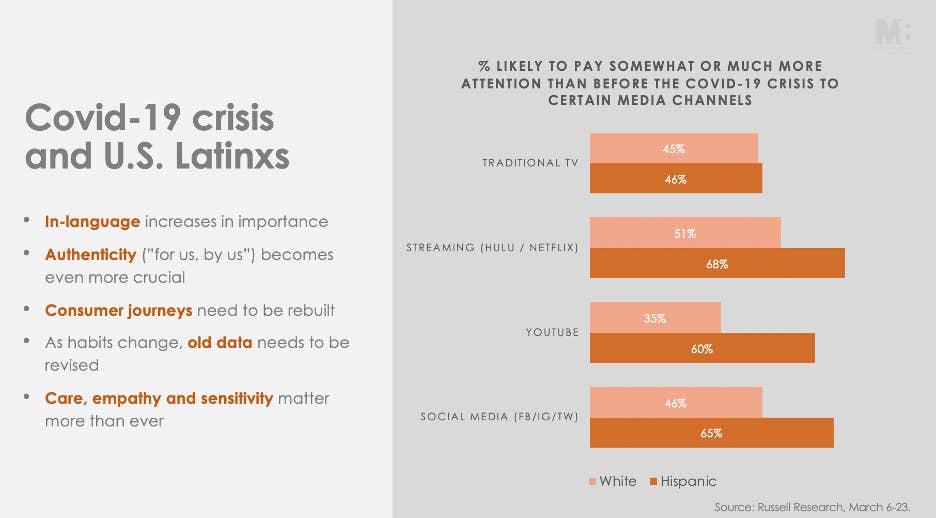The Latinx consumer is the fastest growing segment in the U.S. According to Nielsen, the U.S Hispanic population is increasingly becoming the primary source of growth relative to any other ethnic or racial group -- defining multiculturalism as the new normal.
Latinx buying power has been growing at an exponential rate. It has increased from $494 billion to $1.5 trillion over the last 8 years. Beyond purchase power, the influence of Latinxs in U.S. culture has recently hit new milestones. For instance, the last Superbowl halftime show was a testament to the crucial impact that Latinos and Latinas have in the U.S. market. So, how should a brand engage with this rising demographic? By building deeper, stronger relationships by recognizing cultural traits.
Let’s first start by recognizing common misconceptions marketers make when reaching out to this audience:
- Targeting Latinx consumers as the same. A generic approach can be detrimental as it reveals a lack of care for Latinx audiences. The majority of marketers see Latinx consumers through the lens of race. However, Latinx refers to ethnicity – meaning that individuals come from a diversity of ethnic backgrounds.
- Not understanding “language dominance.” The Latinx consumer does not pick a definitive language to use throughout the day. Many Latinxs move back and forth between English and Spanish based on convenience but also on emotion. It’s safe to say that while most Latinxs in the U.S. could be qualified as ‘English-dominant”, over half of them choose at least some Spanish when they are online, and that proportion changes on different activities like listening to audio content or interacting at home.
How can brands build better relationships with the Latinx consumers?
- Understand that diversity and inclusion is not multicultural marketing. While Diversity & Inclusion Marketing and Multicultural Marketing are not synonyms, Multicultural Marketing allows for solid brand building based on the recognition of diverse traits in people, and its inclusion in overall business strategies.
- Lean into changing demographics and culture relevance. According to Nielsen data, Latinxs are trendsetters, culture-driven shoppers and extremely connected and mobile. Leaning into these trends and ensuring that your brand is culturally relevant can bring new audiences to your brand, help establish a differentiation, and can also help future proof your business.
- Culture cues matter. 60% of the population stated that advertising made specifically for them reflects their cultural background and most importantly, their cultural values. When a brand is categorized as a "brand that understands me" by a Latinx consumer, there is increased loyalty, organic amplification and out-of-category consideration.?
Sprint’s Altarcitos Campaign
M8 and Sprint have solidified meaningful connections with a campaign called “Altarcitos.” Mexican culture doesn’t regard Day of the Dead with sadness, but rather with celebration and altars full of offerings. For that reason, three years in a row, Sprint brought the altars online, evolving the artistic approach year after year and prompting people to share their digital altars on social networks. With more than 5k Altarcitos created and +3M impressions (in 2018 alone), Sprint’s Day of the Dead campaign’s Digital Altarcitos remain highly relevant to users, journey after journey. The ability to take risks like putting together a successful campaign based on a topic so sensitive showcases the importance and opportunity in cultural cues.
Reaching Latinxs during Covid-19
We cannot ignore the new normal ahead of us. Many Latinxs are being affected by a de-prioritization of in-language and in-culture messaging, which matters more than ever in a context where they need to receive very clear communication and assistance. At the same time, almost 60% of marketers seem to be implementing or preparing Hispanic outreach programs. However, this is yet far from the General Market benchmark, and it represents an opportunity for brands to take action soon.
It is imperative for marketers to convey authenticity and empathy in brand communications and actions. It’s also important to turn in-language into a need, not just a nice to have. Ultimately, trust is built on acknowledgment and a common ground.

This blog post highlights key insights from a LiveTalk hosted by M8: Building Meaningful Relationships with Latinx.

